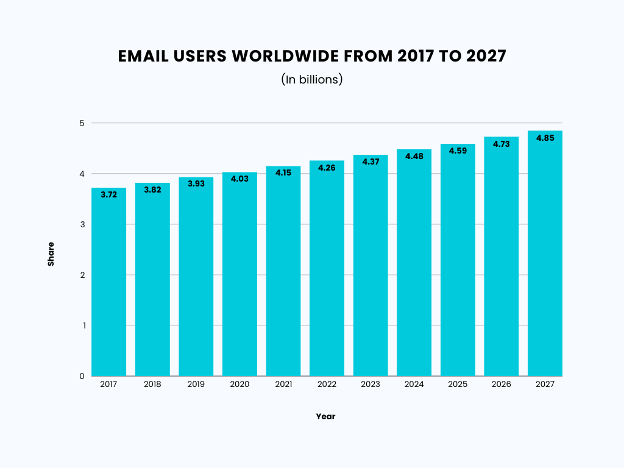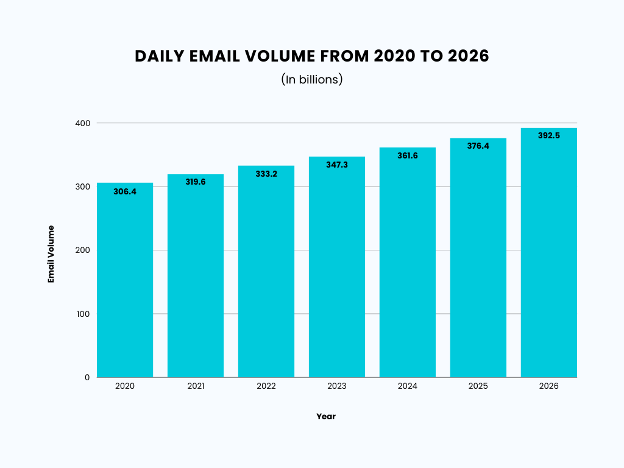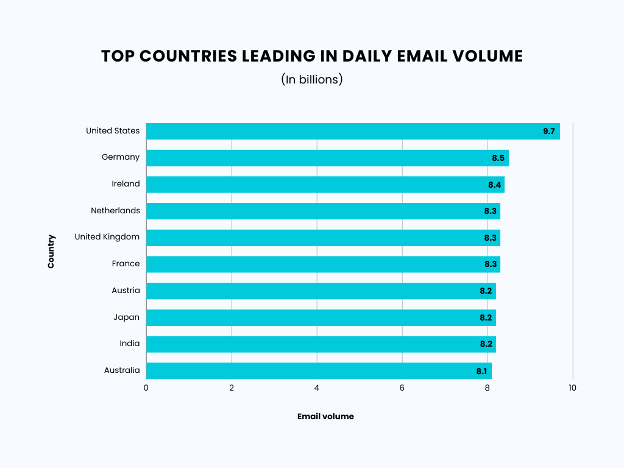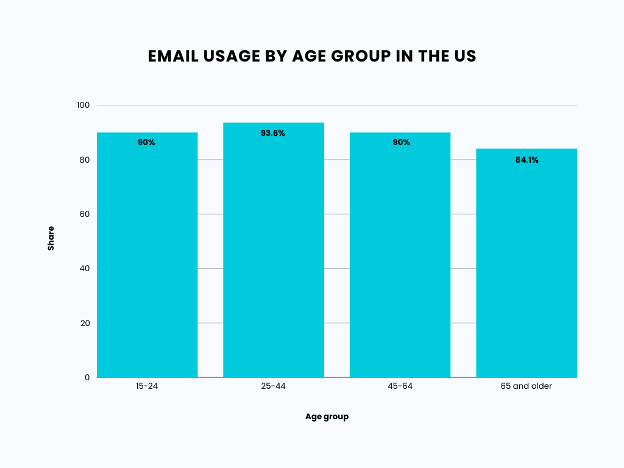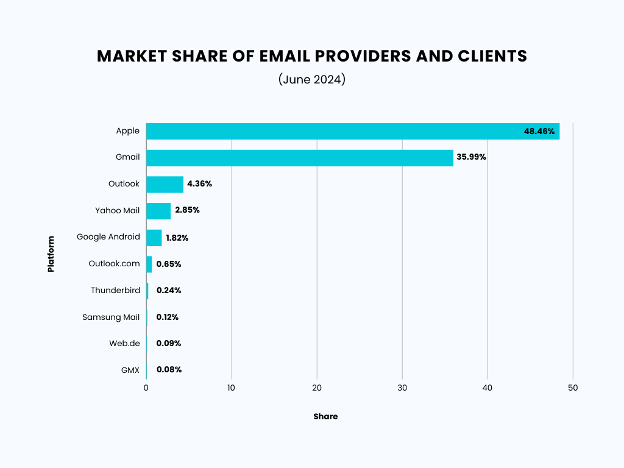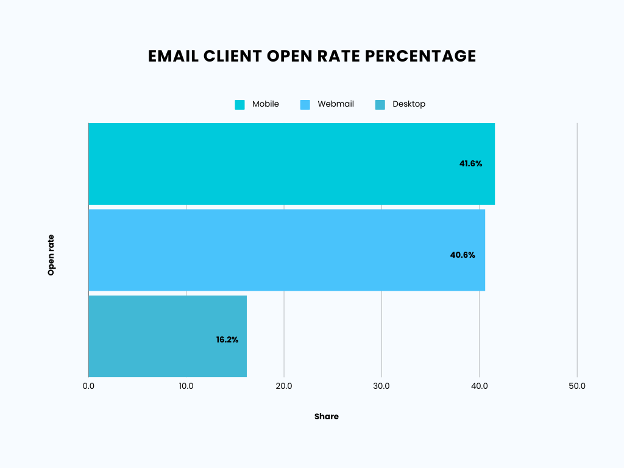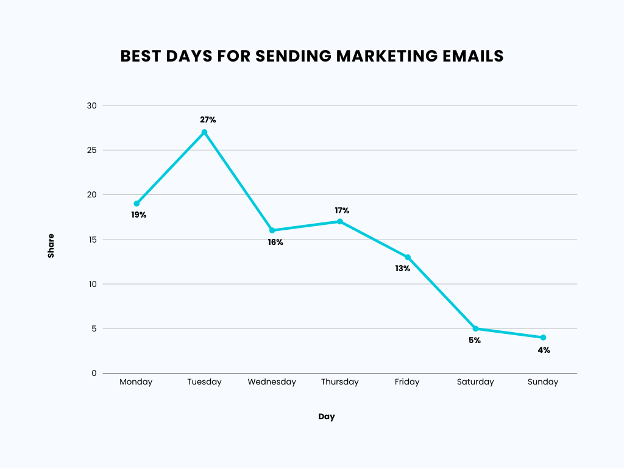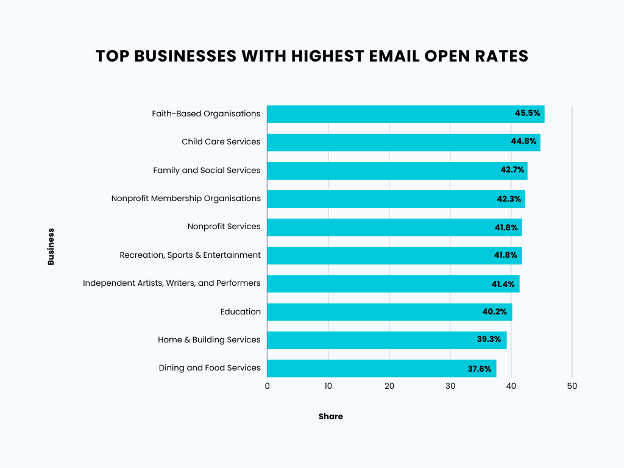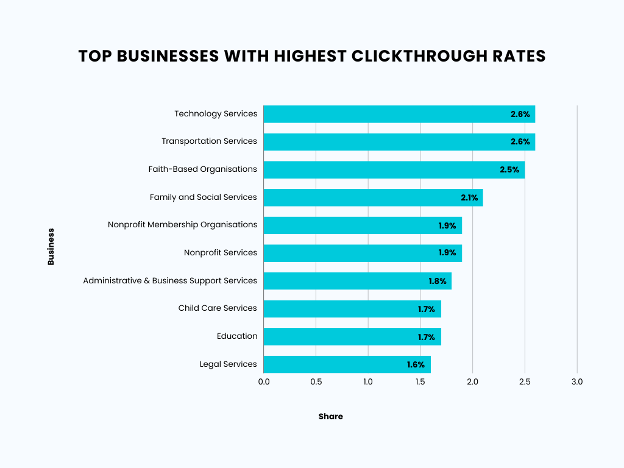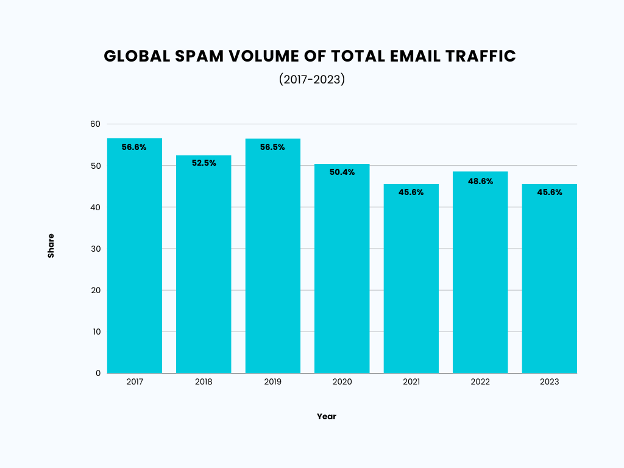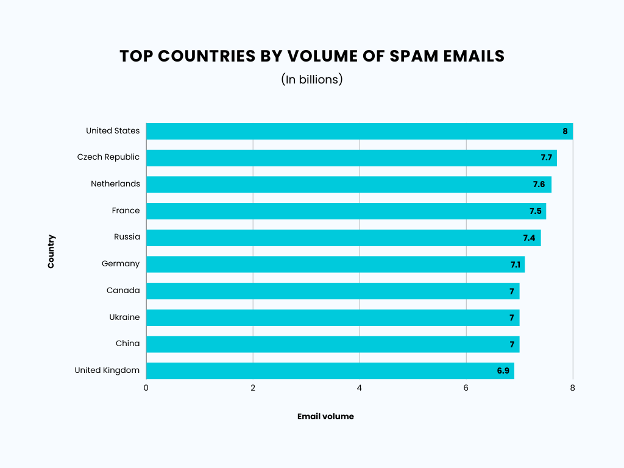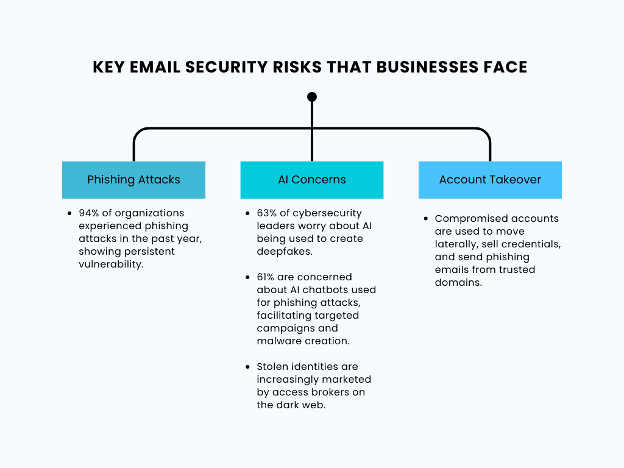
A Comprehensive Guide to Email Worldwide Statistics
Email is a powerhouse. Even today, when instant messaging and social media have become dominant, email maintains its relevance. In business, especially, brands rely heavily on email for marketing and official correspondence. In fact, 62.86% of professionals use email for business communication over other tools. Email not only maintains a professional image but also enhances credibility and makes a lasting impression on customers. Like brands, email is the preferred means of communication for consumers. About 86% of consumers said they want to hear from businesses they frequent, and 60% chose email as their preferred method.
Outside the business world, sending emails is still prevalent. Let’s take a closer look at global email statistics to see its influence more than 50 years after the first email was sent.
Email User Growth
Despite the rise of mobile messengers and chat apps, email remains crucial for daily online life. For personal and work use, global email users are growing daily. In 2024, email users are expected to reach 4.48 billion. Analysts predict this number will continue rising to 4.85 billion in 2027.
From 2024 to 2026, the annual growth rate of email is roughly 3%. Global email users are forecasted to grow by 8.2% in just three years.
Here’s a breakdown of the number of email users worldwide from 2017 to 2027:
| Year | No. of Email Users Globally |
| 2017 | 3.72 billion |
| 2018 | 3.82 billion |
| 2019 | 3.93 billion |
| 2020 | 4.03 billion |
| 2021 | 4.15 billion |
| 2022 | 4.26 billion |
| 2023 | 4.37 billion |
| 2024 | 4.48 billion |
| 2025 | 4.59 billion |
| 2026 | 4.73 billion |
| 2027 | 4.85 billion |
It should be noted that the number of email accounts grows faster than the number of users, with an average of 1.75 accounts per user. There are currently more than 7.9 billion active email accounts. More than half of the world’s population uses email for a multitude of reasons, including:
- Reliability: As a medium of communication, email is dependable and professional. This makes it vital for personal messages and business communication that requires a “paper trail.”
- Accessibility: Email is widely accessible to anyone with an internet connection, overcoming language and cultural barriers.
- Integration: Email apps easily connect with other online platforms and services, helping manage personal and professional activities, from online shopping to social media.
Email Usage
Every day, billions of emails are sent and received. By the end of 2024, this will reach nearly 362 billion, an increase of more than 14 billion from 2023. Let’s look at the daily email volume from 2020 to 2026:
| Year | Daily Email Volume Worldwide |
| 2020 | 306.4 billion |
| 2021 | 319.6 billion |
| 2022 | 333.2 billion |
| 2023 | 347.3 billion |
| 2024 | 361.6 billion |
| 2025 | 376.4 billion |
| 2026 | 392.5 billion |
When broken down by country with the highest number of daily emails sent, the United States tops the list with 9.7 billion daily emails. Next are:
- Germany: 8.5 billion
- Ireland: 8.4 billion
In fourth place, there is a three-way tie:
- Netherlands: 8.3 billion
- United Kingdom: 8.3 billion
- France: 8.3 billion
The following countries are in a three-way tie as well:
- Austria: 8.2 billion
- Japan: 8.2 billion
- India: 8.2 billion
Rounding out the top 10 is Australia with 8.1 billion daily emails sent.
Email Usage in the US
In the US, 90% of people older than 15 use email.
Highest Email Usage:
- Ages 25-44: 93.6%
High Penetration Rates:
- Ages 15-24: 90%
- Ages 45-64: 90%
Lowest Email Usage:
- Ages 65 and older: 84.1%
Email Usage in the UK
In the UK, 85% of internet users send and receive emails weekly. Almost all UK email users check personal emails daily. Sending and receiving emails is a top online activity for most age groups, including 74% of users aged 16 to 24 who do it daily.
Let’s go over some quick questions about other key email usage statistics:
How many emails are sent per minute?
- About 149,513 emails are sent every 60 seconds, totalling about 215,298,720 emails daily. (Source: Prosperity Media)
What is the average daily time spent on email?
- Office workers spend up to 8.8 hours a week on email. On average, people spend under two hours a day on emails. (Source: Missive)
What is the average time spent reading emails?
- The average time spent reading an email is 9 seconds. But not all emails are read equally. About 30% get less than 2 seconds of attention, while 41% get between 2 to 8 seconds. Only 29% get the full 9 seconds. (Source: Digital Information World)
What is the average time spent writing an email?
- The average employee drafts 112 emails a week, spending over five minutes on each. That totals around eleven hours per week on work emails. (Source: Missive)
Email Providers and Clients
There are many email providers and platforms for viewing and managing emails. However, the email providers with the largest market share are:
| Email Client | Market Share (as of June 2024) | Includes Open from |
| Apple | 48.46% | All Apple products, including Mail Privacy |
| Gmail | 35.99% | Gmail (web browser), Gmail mobile app (Android and iOS) |
| Outlook | 4.36% | Desktop opens in Outlook |
| Yahoo Mail | 2.85% | Yahoo Mail (web browser), Yahoo Mail (Android and iOS) |
| Google Android | 1.82% | Mail app on an Android device (excluding the apps that use image caching) |
| Outlook.com | 0.65% | Outlook webmail on a web browser |
| Thunderbird | 0.24% | All opens on the Mozilla Thunderbird |
| Samsung Mail | 0.12% | Samsung Mail app on Android |
| Web.de | 0.09% | German-based webmail or mobile app web.de |
| GMX | 0.08% | German-based webmail or mobile app GMX |
Source: Litmus
With a nearly 49% market share, Apple ranks number one. Almost half of all email users worldwide use Apple to send or receive electronic mail. Gmail ranks number two with a roughly 36% market share. That means more than one in three email users in the world uses Gmail. Apple and Gmail’s combined market share is nearly 85%. That means more than four of five users use these two email providers.
As for email clients, here’s the open rate percentage:
- Mobile: 41.6%
- Webmail: 40.6%
- Desktop: 16.2%
Mobile Email Usage
Mobile has undeniably become the primary platform for email consumption. According to Porch Group Media:
- Mobile is the preferred choice: 75% of Gmail users opt for smartphones or tablets to check their emails. This preference extends beyond Gmail, with approximately 3 in 5 consumers checking their email while on the go.
- Mobile devices have a significant user base: 35% of business professionals rely on their mobile devices to manage their email.
- Mobile drives website traffic: Mobile emails are highly effective at directing users to websites. There’s a 65% increased likelihood of website visits after reading an email on a mobile device.
- An overwhelming usage of smartphones: Mobile email views significantly outnumber desktop views, with numbers as high as triple the desktop usage in some cases.
Email Marketing
Social media and influencer marketing are popular, but email marketing remains the most effective strategy. It offers an average return of $36 for every $1 spent. Specifically, here’s the ROI for every dollar spent on email marketing:
| Industry | ROI per $1 Spent |
| Media, Publishing, Events, Sport & Entertainment | $32 |
| Software & Technology | $36 |
| Marketing, PR & Advertising Agency | $42 |
| Retail, eCommerce & Consumer Goods | $45 |
Source: Forbes
Thus, 81% of businesses use email as a core marketing strategy, helping them:
- Nurture customer relationships
- Drive conversions
- Deliver targeted messages
- Track engagement
- Measure campaign success
One-third of marketers use email marketing. Nearly 90% plan to maintain or increase spending on email campaigns, showing its proven ROI and effectiveness in driving sales. Marketers appreciate email’s ability to:
- Reach a targeted audience directly
- Support various campaign types, from newsletters to promotions
According to HubSpot, marketers’ email frequency is as follows:
| Percentage of Marketers | Email Frequency |
| 22% | Sends 2-3 times per day |
| 21% | Sends daily emails |
| 12% | Sends a weekly email |
Most marketers determine their email frequency based on past engagement data.
Moreover, the best days to send marketing emails are:
| Day of the Week | Best Day for Sending Marketing Emails |
| Monday | 19% |
| Tuesday | 27% |
| Wednesday | 16% |
| Thursday | 17% |
| Friday | 13% |
| Saturday | 5% |
| Sunday | 4% |
Tuesdays have the highest performance, while weekends are the worst.
Here are the key metrics that companies track when reporting on marketing emails:
| Metrics | Percentage |
| Clickthrough rate | 34% |
| Open rate | 31% |
| Leads or email conversions | 27% |
| Traffic from email campaigns | 20% |
| Click rate | 17% |
Most marketers report an average email open rate of 46-50%, a clickthrough rate of 2.6-3%, and a click rate of 7-9%. Emails with images have a nearly 10% boost in open rates.
Here are the top businesses with the highest email open rates:
| Business Type | Email Open Rate |
| Faith-Based Organisations | 45.5% |
| Child Care Services | 44.8% |
| Family and Social Services | 42.7% |
| Nonprofit Membership Organisations | 42.3% |
| Nonprofit Services | 41.8% |
| Recreation, Sports & Entertainment | 41.8% |
| Independent Artists, Writers, and Performers | 41.4% |
| Education | 40.2% |
| Home & Building Services | 39.3% |
| Dining and Food Services | 37.6% |
Conversely, here are the top businesses with the highest clickthrough rates:
| Business Type | Email Clickthrough Rate |
| Technology Services | 2.6% |
| Transportation Services | 2.6% |
| Faith-Based Organisations | 2.5% |
| Family and Social Services | 2.1% |
| Nonprofit Membership Organisations | 1.9% |
| Nonprofit Services | 1.9% |
| Administrative & Business Support Services | 1.8% |
| Child Care Services | 1.7% |
| Education | 1.7% |
| Legal Services | 1.6% |
Source: Forbes
These insights show the importance of targeted, meaningful content. Emails aligned with audience interests drive higher engagement and stronger connections.
Spam and Unsolicited Emails
Nearly half—45.6% in 2023—of emails sent are spam. While still significant, the share of spam emails has been decreasing yearly. Here’s the global spam volume as a percentage of total email traffic from 2017 to 2023:
| Year | Spam Percentage of Total Email Traffic |
| 2017 | 56.6% |
| 2018 | 52.5% |
| 2019 | 56.5% |
| 2020 | 50.4% |
| 2021 | 45.6% |
| 2022 | 48.6% |
| 2023 | 45.6% |
Source: Statista
Here are the typical spam types sent daily:
| Spam Type | Percentage of All Spam |
| Marketing/Advertising | 36% |
| Adult Content | 31.7% |
| Financial Matters | 26.5% |
| Scams and Fraud | 2.5% |
Source: Mailmodo
About 96% of phishing attacks use email. Phishing emails might ask you to:
- Click on malicious attachments or links: These may contain malware like ransomware.
- Click on a fake link: This redirects you to a fake site to steal your personal information.
- Transfer money: They might try to trick employees, especially in finance, into sending money to a fake account.
Now, here are the top countries with the highest volume of spam emails sent daily:
| Country | Volume of spam emails |
| United States | 8 billion |
| Czech Republic | 7.7 billion |
| Netherlands | 7.6 billion |
| France | 7.5 billion |
| Russia | 7.4 billion |
| Germany | 7.1 billion |
| Canada | 7 billion |
| Ukraine | 7 billion |
| China | 7 billion |
| United Kingdom | 6.9 billion |
Source: Statista
In the US, the top 10 states most affected by phishing scams are:
- Nevada
- District of Columbia
- New Jersey
- California
- New York
- Florida
- New Hampshire
- Washington
- Illinois
- Wyoming
Source: Forbes
Cloudflare reported that nearly 52% of the time, cybercriminals impersonated these top global brands:
- Microsoft
- World Health Organization
- SpaceX
- Salesforce
- Apple
- Amazon
- T-Mobile
- YouTube
- MasterCard
With flexible and remote workforces creating new gaps in cloud security, cybercriminals exploit weaknesses in email services’ built-in protections. In 2023, 46% of all threats blocked by Trend Micro were email threats.
In 2023, there were nearly 450K Business Email Compromise detections. Of these:
- Over 160K BEC attacks were detected by Trend Micro.
- Over 280K were detected by the anti-spam tool.
Cybercriminals impersonate executives. They use spoofed names and add high-ranking positions to appear credible. With the rise of sophisticated AI tools, BEC scams will be harder to detect.
Email Security and Data Privacy
With billions of spam messages sent daily, email security and data privacy are more important than ever. Here are some key email security risks that businesses face (Source: Egress):
Phishing Attacks
- 94% of organisations surveyed experienced phishing attacks in the past year. This is relatively similar to the 92% in 2023, showing persistent vulnerability.
AI Concerns
- 63% of cybersecurity leaders worry about AI being used to create deepfakes, while 61% are concerned about AI chatbots being used for phishing attacks. Large Language Models and generative AI help cybercriminals create targeted phishing campaigns and generate malware.
- CrowdStrike has found a growing market for stolen identities. Access brokers are increasingly advertising valid credentials on the dark web.
Account Takeover
- Account takeovers are a major issue in cybersecurity. Attackers can use a compromised account to move laterally, sell credentials, and send phishing emails from a trusted domain.
Trends in Email Technology
Here are the fastest-growing trends in email marketing right now, driven by innovative changes:
Leveraging Artificial Intelligence
Nearly three-fourths of marketing departments are already using generative AI tools. ChatGPT, Gemini, and Perplexity are mainly used to write articles and create social media images. However, email marketers are also starting to use Aim, focusing on:
- Campaign Management: AI helps marketers analyse campaign performance and find areas for improvement.
- Content Creation: Generative AI platforms can write, outline, and edit email copy and create images.
- Brainstorming: AI assists in generating subject lines, newsletter topics, and more.
- Scaling Output: AI speeds up time-consuming tasks like brainstorming, content creation, and campaign analysis.
Using Integrations to Expand Email Capabilities
To improve efficiency and customer experience, businesses increasingly use a growing email marketing integrations network. Mailchimp, a prominent email service provider, offers 250+ app integrations. These integrations help businesses:
- Track customer engagement
- Automatically share information on email campaigns
- Create professional newsletters
Increasing Personalisation
The average person receives 121 business emails per day, many of which are ignored. Consumers demand personalisation. People are less interested in generic, sales-focused emails. Addressing customers by name in the subject line can grab attention, but effective email marketing now focuses on personalising content based on consumer behaviour data.
Improving Accessibility for Broader Reach
Roughly 1.3 billion people worldwide have some form of disability. Improving email accessibility isn’t just the right thing to do, but it’s a government regulation. For businesses, this also boosts brand credibility. Here are ways to make emails more accessible:
- Ensure the text is easy to read against the background.
- Provide descriptions for images so screen readers can convey the content.
- Limit flash to 2 Hz to 55 Hz to avoid seizures.
- Make sure the email looks good in dark mode.
- Ensure the text is large enough to be read easily.
Utilising Sophisticated Automation Tools
With advancements in AI, email automation is simpler and more effective than ever. More businesses will adopt complex automated email sequences. Brands will invest in tools that streamline automation, making it easier to set up integrations and dashboards. New tools will also help gather detailed data on customer preferences and behaviour for enhanced personalisation and optimisation.
Final Thoughts
It has been half a century since Ray Tomlinson sent the first email. With the upcoming trends in email for personal and work use, as well as the advanced innovation in marketing, email will remain a strong communication tool. And what’s not to like? It’s reliable, accessible, and effective.
Innovation is the future of email. For every spam sent, new emerging technologies to ensure robust security measures arise. Email isn’t done yet. As long as third-party platforms and tools require authentication and permission, our inboxes will remain full.



